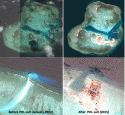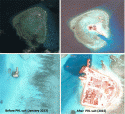I should clarify a bit more about the Philippines arguments and the aftermath
On Itu Aba is a rock not an island.
China has chosen an opt out clause in UNCLOS (article 298) which will mean it doesn't have to subject itself to arbitration on maritime boundaries with EEZs. The court also does not deal with sovereignty issues, which China feels this is.
So the Philippines counter argument is, well there is no need to determine maritime boundaries, because your holdings (even assuming they belong to you) can't generate an EEZ in the first place. So its not a sovereignty issue because even if you hold those islands, we get the majority of EEZs. Hur hur hur hur.
This is a tactic to give the court jurisdiction over the dispute by framing it not as a dispute over maritime boundaries, but an issue of denying a nation its EEZ. Johnny Cochcran would be proud.
Its obviously advantageous for those claimants in the SCS whose major territory is close to it, to deny the EEZs from the Spratly's, which kind of makes the point of claiming them in the first place useless from an economic point of view.
What will happen next
This is a bit of speculation on my part of course
Lets start with the case that Itu Aba is a rock fails. Under the rules it would become a maritime boundary dispute, and outside the Court’s purview. The Philippines have already stated they will then file a second suit to call for conciliation with China, which has less power. This would quite a victory for China, especially when they win without turning up.
Now lets give the opposite scenario. So Itu Aba is a rock. Options available to China are
a. Withdraw from UNCLOS
b. Wait for it to be taken up to the UN and veto it
c Comply to some extent
Option A. Well the US isn't a signatory of UNCLOS and it claims EEZs from territories which are uninhabited, quite a few islands actually. So certainly claiming EEZs are not being a member of UNCLOS is not unprecedented.
Option B.
The Article 94 of the UN charters states:
1) Each Member of the United Nations undertakes to comply with the decision of the International Court of Justice in any case to which it is a party.
2) If any party to a case fails to perform the obligations incumbent upon it under a judgment rendered by the Court, the other party may have recourse to the Security Council, which may, if it deems necessary, make recommendations or decide upon measures to be taken to give effect to the judgment.
So if China refuses to give in, the recourse is to take it to the security council where China will veto it. The US has exercised veto power in regards to Israel without embarrassment, so to can China.
Option C
If China complies, then all that’s left is using those bases as a shelter for fishermen or as a military base. This is unlikely to happen.
On Itu Aba is a rock not an island.
China has chosen an opt out clause in UNCLOS (article 298) which will mean it doesn't have to subject itself to arbitration on maritime boundaries with EEZs. The court also does not deal with sovereignty issues, which China feels this is.
So the Philippines counter argument is, well there is no need to determine maritime boundaries, because your holdings (even assuming they belong to you) can't generate an EEZ in the first place. So its not a sovereignty issue because even if you hold those islands, we get the majority of EEZs. Hur hur hur hur.
This is a tactic to give the court jurisdiction over the dispute by framing it not as a dispute over maritime boundaries, but an issue of denying a nation its EEZ. Johnny Cochcran would be proud.
Its obviously advantageous for those claimants in the SCS whose major territory is close to it, to deny the EEZs from the Spratly's, which kind of makes the point of claiming them in the first place useless from an economic point of view.
What will happen next
This is a bit of speculation on my part of course
Lets start with the case that Itu Aba is a rock fails. Under the rules it would become a maritime boundary dispute, and outside the Court’s purview. The Philippines have already stated they will then file a second suit to call for conciliation with China, which has less power. This would quite a victory for China, especially when they win without turning up.
Now lets give the opposite scenario. So Itu Aba is a rock. Options available to China are
a. Withdraw from UNCLOS
b. Wait for it to be taken up to the UN and veto it
c Comply to some extent
Option A. Well the US isn't a signatory of UNCLOS and it claims EEZs from territories which are uninhabited, quite a few islands actually. So certainly claiming EEZs are not being a member of UNCLOS is not unprecedented.
Option B.
The Article 94 of the UN charters states:
1) Each Member of the United Nations undertakes to comply with the decision of the International Court of Justice in any case to which it is a party.
2) If any party to a case fails to perform the obligations incumbent upon it under a judgment rendered by the Court, the other party may have recourse to the Security Council, which may, if it deems necessary, make recommendations or decide upon measures to be taken to give effect to the judgment.
So if China refuses to give in, the recourse is to take it to the security council where China will veto it. The US has exercised veto power in regards to Israel without embarrassment, so to can China.
Option C
If China complies, then all that’s left is using those bases as a shelter for fishermen or as a military base. This is unlikely to happen.



